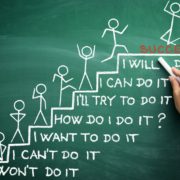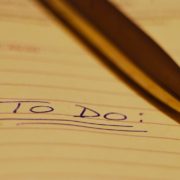There are times when I have felt disheveled, out of place. or just unorganized. It could also be described as just feeling off-balance. Whatever it is or whatever you want to call it, spending some time collecting my thoughts usually helps.
Read moreTag Archive for: Goal Setting
During the end of a calendar year and at the beginning of a new one, I am frequently asked if I set goals and what does that look like? Well, it is not as simple as JUST setting goals for the year. For me, there is a lot more that goes into ending a year and beginning a new one. I believe it is about intentionality. I like to be deliberate in how I end and start a year. Why? Well, it gives me clarity and a vision forward…a path if you will.
So I thought it would be helpful to share the process I use for myself and my coaching clients. This way others can adopt it or at the very least use it as a guide to start their own practices. It really has worked well for me. Over the last few years, I have set myself up for success with these steps. In fact, each of my last 4 years has been better than the last and this has not happened by chance. When I look back I have been blown away by the goals I completed and how my life has changed in so many areas. To be honest, I didn’t complete every goal that I set each of these years (and that is okay).
Over the years I’ve tried different ways and I recognize that each individual is their own person and has their own way of doing things. So you’ll need to tweak this for yourself. Just use the following steps as a guide to help.
Each of the below steps is (or will be) its own blog post. Just click on the hyperlink and a new window will open.
#1 Reflect. We can’t look forward unless you take some time to look where you’ve come from. So take some time and reflect on the year that is ending. Think about what went well, what you want to change, and what you should get rid of. Click here to read about how to reflect on the year.
#2 Know the present you. Where are you now? What is your life like in all areas? To get a good snapshot of where you are, take the time to complete my Wheel of Life assessment. Make sure you complete the accompanying worksheet since it will give you a more in-depth look of where you are and where you want to go. Click here to read more about the Wheel of Life assessment (3 minute read).
#3 Set the tone for the coming year. Select a word to help define what you want this year to look like or it could be a word to help keep you grounded and on track. Many have done this for years.
#4 Set your goals. I use the S.M.A.R.T.E.R. goal method and I don’t set more than 5-7 goals at a time, otherwise, it could become unwieldy and overwhelming. If this is all new to you then I wouldn’t have more than 5 goals at any one time. And the goals you set should not be easy to achieve. They should push you outside your comfort zone and move your life forward in the direction you want it to go. Use the results from the Wheel of Life assessment to decide on what categories of your life you want to improve and also incorporate your word of the year. Click here to read more about all the details of SMARTER goals (4-minute read).
#5 Make the time. Now you need to set aside time to work on these goals because they won’t just accomplish themselves. Start with a calendar for the entire year and set milestones for each goal, then take that down to what needs to get done each month. What I also recommend is to set time each week just to move your goals forward. This will look different for each person but how much time do you think you need each week to work on your goals? Now find that time and put it on your calendar. What gets scheduled gets done.
#6 Review on a regular basis. I have found that a best practice is to schedule a quarterly review to go over your goals. I do this to make sure my goals still align with what I want. I also want to see where each goal is in the process. Here are a couple of the questions I ask myself: What are my obstacles? What can I do now to move the needle forward? In addition to the quarterly review, set a reoccurring calendar appointment for yourself to review your goals on a weekly basis. This will allow for you to determine what needs to get done each week and not forget about it.
Now, all of this might seem like a lot of work but I have found that it pays off in big dividends at the beginning and the end of each year. This process gives me the structure I need to set up my year for success.
[Tweet “This process gives me the structure I need to set up my year for success.”]
You can complete each step separately. It doesn’t all have to be done in one day – although it can be.
Trust the process and give it a try.
Click here to sign up to my email community and don’t miss another update!
Let me know what you think of this process and what questions you have.
Writing is a powerful practice. It has various effects including discovering ideas, defining goals, and solidifying steps. The act of writing means you have to organize your thoughts and this is the first key step in accomplishing any goal or dream.
A study done at Dominican University illustrated the difference between students who wrote down their goals and those who did not. Guess which group was more likely to reach their goals? You guessed it – the group who wrote them down. Read more
[guestpost]This is a guest post by Amy Collinsworth who works at Boston University as the Student Outreach Manager for the Center for Career Development and the Educational Resource Center. She holds a bachelor of arts in marketing from Rockford University and a master of science in college student personnel from the University of Tennessee. Amy’s professional background includes working in MBA career management and undergraduate student leadership development. You can connect with her at @AmyCollinsworth[/guestpost]
“Today we will drive to the parking lot at your school, and by using the tool we learned about in the Tony Robbins recording*, you will make the basketball into the basket on your first shot!” dad said. I was not sure what to expect as we drove to the parking lot at Thompson Elementary that breezy spring afternoon, but I was certain my petite 4-foot-tall frame and poor hand-eye coordination would be my down-fall in making the basket. I got out of the car and walked to the hoop, carefully positioning myself a few feet in front of the hoop on the center of the faded white spray painted line.
I took a deep breath and closed my eyes.
Take a minute and close your eyes. Think about one thing you have always wanted to do. What would you achieve if you had no fear, monetary constraints or obstacles in your way? Envision accomplishing your biggest dream or most outlandish goal. What is that big dream for you?
With your dream in mind, there are hundreds of people who set out last week to turn their dream into reality. Some have been thinking about this dream for years and others for decades. Their dream…to standing on top of the world!
[featured-image single-newwindow=”false”]Photo Credit: Rupert Taylor-Price via Compfight cc[/featured-image]
This first week of April marks the beginning of Everest season. A time of excitement and anticipation. For some, years and months of training and fundraising have ended. And now the hard work begins. Those climbers have arrived in Kathmandu to attempt to complete the dream of a lifetime. So as a tribute to the dream of reaching the summit of Everest (which is something I hope to do one day) here is a 3 step process to get your dreams in order and start accomplishing them. Read more
How many of us when feeling stressed and overwhelmed think if I create a to-do list and get everything I need to do on paper I will feel less stressed. Well, there is some truth to this. By putting everything that needs to get done on paper gets it out of your mind. But when you then go and look at your long to-do list you feel overwhelmed at the sheer magnitude of the list. It’s time to stop using a traditional to-do list. [Tweet This]
[featured-image single-newwindow=”false”]
Photo Credit: Mattox via Stock.XCHNG cc
Call long to-do lists what they really are – long term things you might get done, some day. [Tweet This] Don’t create a long to-do list to accomplish every day. It can be so daunting. [Tweet This] Instead create your 3 Must Do’s for each day. Read more
The one action you must take before setting any goals is REFLECTION.
Reflecting on where you have been and where you are is important to determining where you are going to go. [Tweet This]
“Without reflection, we go blindly on our way, creating more unintended consequences, and failing to achieve anything useful.” ~Margaret J. Wheatley
Benefits of Reflection
- Understand the why. Through reflection you can start to figure out why you want to set this particular goal. Knowing the why will give the goal a deeper purpose. Because you know the true purpose you will be more likely to succeed.
- Understand who you are. Reflecting on why goals are important and our purpose behind them will help you understand yourself better. Knowing who we are can give each of us a better idea of how we have come to be this way and where we want to go in the future.
- Understand ways to change and improve. Goals are about change. Using reflection as a tool can empower each of us to see areas in our lives needing change or improvement. Change is how we as humans grow, become better people, and accomplish great things!
How To Use Reflection in Goal Setting
1. Determine the goal you want to set.
Example: I will lose 10 pounds in the next 10 weeks.
2. Why is this goal important to you? What is driving you to complete this goal? Restate the goal from above and add “because” to the end of the sentence and answer the why?
Example: I will lose 10 pounds in the next 10 weeks BECAUSE I want to feel better about my body. have more energy and create healthy habits.
3. Ask yourself: What has stopped me from accomplishing this goal in the past?
Example: I didn’t have any idea how to lose 10 pounds or I wasn’t losing the weight as quickly as I thought I would.
4. What fears do I have about this goal?
Example: I am afraid I won’t lose the 10 pounds and accomplish my goal and be seen as a failure.
5. How do you think you will feel when you accomplish this goal?
Example: I will feel like I have more energy, feel better about myself, and feel like I am more active.
By taking the time to reflect on a goal you want to set you will be intentionally considering why this particular goal is important to you, why you want to accomplish it and the obstacles you may face that could deter you.
Spending time reflecting will increase the probably of following through and accomplishing your goal.
What other questions do you use to reflect and help establish your goals?
Well, it is finally here, 2013 has begun…so let the resolutions begin! Did you know that, according to the Journal of Clinical Psychology (Volume 58, Issue 4), “people who explicitly make resolutions are 10 times more likely to attain their goals than people who don’t explicitly make resolutions.”









